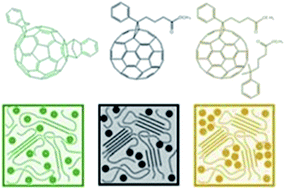Origin of fullerene-induced vitrification of fullerene:donor polymer photovoltaic blends and its impact on solar cell performance†
Abstract
Organic solar cell blends comprised of an electron donating polymer and electron accepting fullerene typically form upon solution casting a thin-film structure made up of a complex mixture of phases. These phases can vary greatly in: composition, order and thermodynamic stability; and they are dramatically influenced by the processing history. Understanding the processes that govern the formation of these phases and their subsequent effect on the efficiency of photo-generating and extracting charge carriers is of utmost importance to enable rational design and processing of these blends. Here we show that the vitrifying effect of three fullerene derivatives ([60]PCBM, bis[60]PCBM, and [60]ICBA) on the prototypical donor polymer (rr-P3HT) can dominate microstructure formation of fullerene/donor polymer blends cast from solution. Using a dynamic crystallization model based on an amalgamation of Flory–Huggins and Lauritzen–Hoffman theory coupled to solvent evaporation we demonstrate that this vitrification, which can result in a large fraction of highly intermixed amorphous solid solution of the fullerene and the polymer, is due to kinetic and thermodynamic reasons. The former is partly determined by the glass transition temperature of the individual components while donor polymer:fullerene miscibility, strongly influenced by the chemical nature of the donor and the fullerene and leading to thermodynamic mixing, dictates the second phenomena. We show that our approximate dynamic crystallization model assists understanding the different solid-state structure formation of rr-P3HT:fullerene blends. Due to the generality of the assumptions used, our model should be widely applicable and assist to capture the influence of the different vitrification mechanisms also of other photovoltaic blends, including the high-efficiency systems based on the strongly aggregating PCE11 (PffBT4T-2OD), which also feature clear signs of vitirfication upon blending with, e.g., [60]PCBM. Hence, our model will provide essential materials design criteria and enable identification of suitable processing guidelines for existing and new high-performing blends from the outset.

- This article is part of the themed collection: Celebrating Excellence in Research: Women of Materials Science


 Please wait while we load your content...
Please wait while we load your content...